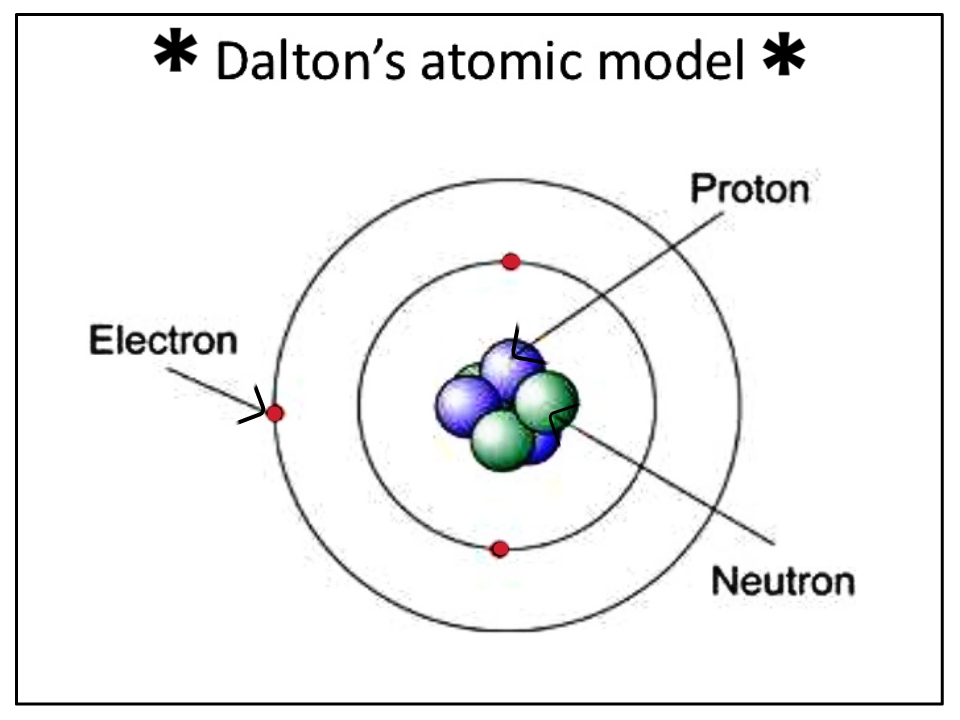Today, we wonder how to draw an atom. The University of Houston's College of Engineering presents this series about the machines that make our civilization run, and the people whose ingenuity created them.
It was gentle John Dalton who finally sorted out the rumblings of late 18th-century chemists and gave us a proper atomic theory. Dalton lived a quiet life of modest means. He was a bachelor and a devout Quaker who showed little passion of any kind. One subject did elicit a flare of anger, though. That was the debate over how to represent chemical combinations. And therein hangs our tale.
Dalton spent his life licking the wounds of an early failed love. For the rest, he tutored students, he had his one nightly pint of ale, and he studied. His only pastime was lawn bowling, and that becomes part of our story. His friends described him as awkward, strident, without social grace, and admirably independent.

John Dalton Atom Model
Teori atom Dalton adalah teori paling tua mengenai penjelasan tentang atom.Dalton menjelaskan bahwa atom merupakan suatu zat nyang tidak bisa dibagi - bagi lagi. Teori atom Dalton adalah teori mengenai atom yang dikemukakan oleh ilmuwan berkebangsaan Inggris, John Dalton pada tahun 1808.
Today, we wonder how to draw an atom. The University of Houston's College of Engineering presents this series about the machines that make our civilization run, and the people whose ingenuity created them. It was gentle John Dalton who finally sorted out the rumblings of late 18th-century chemists. The Solid Sphere Model was the first atomic model and was developed by John Dalton in the early 19th century. He hypothesized that an atom is a solid sphere that could not be divided into smaller particles. He came up with his theory as a result of his research into gases. He realized that certain gases only combined in specific proportions. Teori Atom John Dalton Pada tahun 1803, John Dalton mengemukanan teori atom didasarkan pada dua hukum, yaitu hukum susunan tetap (hukum prouts) dan hukum kekekalan massa (hukum Lavoisier). Menurut Prouts: “Perbandingan massa unsur-unsur dalam suatu senyawa selalu tetap.”.
In 1802, when he was 36, he began forming and setting forth his atomic theory of matter. He showed how matter is made of elemental atoms, and that atoms of each material have a distinct weight. He didn't have the weights quite right. (Today we know that oxygen weighs 16 times as much as hydrogen, carbon 12 times as much, and so forth.) But Dalton clearly saw that when elements combine, they have to do so in fixed proportions.
Next he needed a scheme of notation for chemical reactions. When you and I took chemistry, we wrote formulas like
But that's what displaced Dalton's original notation. When he wrote that formula, he used round circles to identify the atoms. His phosphorus looked like a Mercedes hood ornament. Oxygen was an empty circle, and hydrogen had a dot in the middle. For water, he envisioned a slightly different formula:
and he used two circles for water -- one with a dot in the middle and one empty.
Dalton argued strenuously against our modern notation. And it really was no minor matter. You see, a debate had been raging among scientists. Do we make grand generalizations about nature, or do we just report the facts, carefully and accurately? Edius for mac. Atoms were an ancient theoretical idea from before Aristotle. But the prevailing mood in 1802 was to take Dalton's theoretical atoms as only a metaphor for rules of chemical combination. They weren't real.
But Dalton loved lawn bowling, and his atoms were as real and corporeal as those wooden bowling balls. Some scientists want notation to be abstract. Others want their symbols to representational. That was a major issue in the famous Newton/Leibnitz battle over calculus notation, and it was certainly at issue here.
Yet more than notation was at stake here. Scientists who accepted Dalton's theory backed away from his pictorial notation because that suggested that they were accepting the atoms themselves. Dalton knew perfectly well that chemistry couldn't move forward without such an acceptance. So his legacy reached beyond his theory. It took another 75 years, but we finally granted reality to his invisible bowling balls. We finally created atomic physics.
I'm John Lienhard, at the University of Houston, where we're interested in the way inventive minds work.
Dalton Atomic Theory Discovery Date
Greenway, G., John Dalton and the Atom. Ithaca: Cornell University Press, 1966.John Dalton & the Progress of Science. (D.S.L. Cardwell, ed.). New York: Manchester University Press, Barnes and Noble Inc., 1968.
von Baeyer, H. C., Nota Bene. The Sciences, January/February 1999, pp. 12-15.
See also the article on John Dalton in the Dictionary of National Biography.
John Dalton from an engraving by Worthington
Free office for mac.
Some of Dalton's symbols for the elements
with his estimates of molecular weight
Is there an excel version for mac.
John Dalton Atom Year
